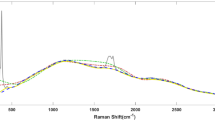Summary
Peak integration is still a major source of error in analytical techniques such as chromatography (LC and GC), aapillary electrophoresis (CE), spectrosocpy, and electrochemistry. If the baseline is complex, e.g. because of matrix effects, or if the peak shape is irregular, e.g. because of peak tailing, the results are often not satisfactory when classical procedures are used. These shortcomings arise because of the stepwise appearance of the chromatogram. An algorithm that copies the human method of considering baseline and peaks as a whole has already been introduced. Here the use of a straight line as a baseline model led to an improvement in several instances. The baseline is, however, usually not exactly straight and rigid. A baseline model with flexible properties is more advantageous. Thus the smoothing cubic spline function is applied in this work. Here the rigidity can be controlled by use of a parameterp k. The prediction interval of the spline is used for iterative distinction between baseline and peak regions. Afterwards straightforward optimization of the peak boundaries is applied. More than 50 series of consecutive injections of the same sample (n=40 on average) were used to test the performance of this procedure. The same raw data have been integrated by means of the algorithm described here and by use of commercially available software. The reproducibility of the main component peak are within the series was taken as a measure of integration quality. Typically the new procedure reducesRSD % by approximately 33% (e.g. from 1.5% to 1.0%). The improvement is even more impressive for difficult samples with complex matrices, e.g. blood plasma or polymer excipients. for such samples improvements of up to a factor of 6 are obtained.
Similar content being viewed by others
References
N. Dyson, Chromatographic Integration Methods, Royal Society of Chemistry, London, 1990.
H. Wätzig, Chromatographia33, 218 (1992).
J. H. Ahlberg, E. N. Nilson, J. L. Walsh, The Theory of Splines and their Applications, Academic Press, New York 1967.
H. Späth, Spline-Algorithmen, 4th edn, Oldenborg, München, 1986.
P. Fleischer, doctoral thesis, Würzburg 1989.
T. N. E. Greville, Theory and Application of Spline Functions, Academic Press, New York 1969.
R. Bulirsch, H. Rutishauser, Spline-Interpolation in: Mathematische Hilfsmittel des Ingenieurs, Springer, Berlin 1968.
A. Sard, Linear Approximation, Am. Math Soc. Surveys 9, Providence 1963.
T. N. E. Greville, Mathematical Methods for Digital Computers, Vol. II, Wiley & Sons, New York, 1967, p. 156.
P. L. J. Rooy, F. van Schurer, A Bibliography on Spline Functions, II. T.H.-Report 73-WSK-01, Technological University Eindhoven 1973.
C. H. Reinsch, Numer. Math.10, 177 (1967).
C. L. Mallows, Technometrics15, 661 (1973).
P. Craven, G. Wahba, Numer Math.31, 377 (1979).
J. Hartung, Statistik, 1st edn, Oldenborg, München, 1982.
Thermo Separation Products Inc., Integration Software for the Spectraphoresis 1000 CE-Instrument Version 3.01, Fremont USA, 1995.
Hewlett Packard GmbH, HP 3D-CE Chemstation Software Version A05.01, Waldbronn, Germany, 1997.
K. D. Altria, R. C. Harden, M. Hart, J. Hevizi, P. A. Hailey, J. V. Makwana, M. J. Portsmouth, J. Chromatogr.641, 147 (1993).
A. Kunkel, S. Günter, C. Dette, H. Wätzig, J. Chromatogr. A781, 445 (1997).
C. Dette, H. Wätzig, Fresenius J. Anal. Chem.345, 403 (1993).
A. Kunkel, S. Günter, H. Wätzig, J. Chromatogr. A768, 125 (1997).
A. Kunkel, S. Günter, H. Wätzig, Electrophoresis18, 1882 (1997).
M. Degenhardt, H. Benend, H. Wätzig, Separation and Quality Control of Pentosanpolysulfate (PPS) by Capillary Zone Electrophoresis (CZE), poster presented at the Ninth International Symposium on High Performance Capillary Electrophoresis and Related Microscale Techniques (HPCE 97), 26-30.1.1997, Anaheim, California, USA.
K. Brinkmann, doctoral thesis, Würzburg, in preparation.
Author information
Authors and Affiliations
Rights and permissions
About this article
Cite this article
Schirm, B., Wätzig, H. Peak recognition imitating human judgement. Chromatographia 48, 331–346 (1998). https://doi.org/10.1007/BF02467701
Received:
Revised:
Accepted:
Issue Date:
DOI: https://doi.org/10.1007/BF02467701




